“Do you have a faster approach to test the shelf life of my disinfectant?” – Is this a common topic you wonder about too? The COVID-19 driven production of disinfectants in our current market has alerted governmental authorities globally to promptly facilitate these products into the market. With an interest to register your product in particular countries, you would need to adhere to the respective disinfectant regulation guidelines produced by these countries.
In Malaysia, hand sanitizers and surface disinfectants are regulated by the National Pharmaceutical Regulatory Agency (NPRA). Other international regulators include the U.S. Food & Drug Administration (US FDA), European Chemical Agency (ECHA) of the European Union, Health Science Authority (HSA) of Singapore, Therapeutic Goods Administration (TGA) of the Australian Government, and more. Varying aspects of the disinfectants are assessed prior to being marketable including proof of microbial efficacy of disinfectants, labelling and packaging, product stability, shelf life and more.
Circling back to the common question we’ve been receiving by manufacturers, TECOLAB assists you in assessing the chemical stability and shelf life of your disinfectants according to the Therapeutic Goods Administration (TGA) instructions for disinfectant testing. The performance of disinfectants are assessed accordingly to the physical and chemical stability, antimicrobial stability and shelf life prediction. In order to prove or predict the shelf life of a disinfectant, we would need to compare the stability of the new product and an aged product. The aging product can be produce with real time studies or accelerated aging test.
Real Time and Accelerated Aging Studies
Shelf life can be assessed with a real time study where the product is tested at the initial stage and annually over the set shelf life of the product. As this approach is time consuming and delays product market placement, customers can opt for accelerated study while undergoing real time testing. Accelerated aging test involves isolating disinfectants as they are packaged into a humidity chamber with elevated test temperature. The temperature increased varies accordingly to the desired shelf life prediction. According to the TGA guidelines, a minimum of four time points is required when undergoing accelerated aging test. Time recommended time points would be 0, 3, 6, and 9 months. The table below demonstrates the shelf life prediction within these time intervals.
| Elevated Temperature Above Storage Temperature | Time Period | Shelf Life Prediction |
| +10 °C | 3 months | 1 year |
| +15 °C | 3 months | 1.5 years |
| +10 °C | 6 months | 2 years |
| +15 °C | 6 months | 3 years |
| +10 °C | 9 months | 3 years |
The shelf life prediction with accelerated aging ranges from 1 to 3 years. Here are additional tips and points to note when an accelerated aging test has been considered:
- Products are to be monitored in a real time aging testing despite having done accelerated aging test. This is to ensure the shelf life predicted via accelerated aging test tallies and/or justifies the shelf life predicted via real time aging.
- Storage conditions of products generally ranges from 25oC to 30oC, elevated temperatures are added according to the shelf life intended to be predicted.
- The active concentration at the end of the accelerated aging test should not be below 90% of the initial active concentration claimed on the product label.
Disinfectant Performance Assessment
The performance or stability of disinfectants are assessed within three aspect, the physical characteristics, chemical stability and antimicrobial efficacy of the product.
Physical Stability
“Is it normal for my disinfectant to look different passing its shelf life?” – Physical properties such as the appearance of disinfectants, pH, boiling point, odor and more are of some of the common characteristics measured and assessed. An important key to note during physical assessment is the material compatibility of the product and the suitability of product with its packaged container. Stability testing with the packaged material is a mandatory requirement as set in the TGA guideline.
Chemical Stability
“Will the active substance in my disinfectant degrade from time to time?” – According to the TGA guideline, these key points are to be considered in chemical stability testing:
- Determining the active concentration of your active substance with an appropriate detection assay,
- Active concentration of active substance should not fall below 90% of the initial label claim at the end of shelf life analysis, and
- All chemical test analysis should run in duplicate samples.
Our chemistry laboratory partner ensures the right analysis most suitable for your disinfectant active substance with the following detection assays via Fourier-Transform Infrared Spectroscopy (FTIR) Analysis, High Pressure Liquid Chromatography (HPLC) Analysis and Gas Chromatography (GC) Analysis.

Antimicrobial Stability
“Do disinfectants have an expiration date?” – The efficacy or antimicrobial property of disinfectants may vary after its shelf life. Various international methods such as European Standards (CEN) and American Society for Testing and Materials (ASTM) are accepted by many international regulators to prove product efficacy. TECOLAB assists all disinfectant manufacturers by planning your antimicrobial stability testing with the spectrum of interest according to specified international methods such as EN 14561, EN 13697, EN 14562 and more. Ensuring the antimicrobial activity is within an active range across your product’s shelf life is our main priority. We also prepare and provide an expert opinion in regards to the correlation of product shelf and its antimicrobial efficacy.
Let us assist you through your disinfectant stability testing today. We are capable of planning, customizing specific test methods and preparing your test report to suit the need of your country’s disinfectant regulators for submission. Contact us here to speak to one of our experts on starting your testing journey with us!
Reference
1. Australian Government Department of Health Therapeutic Goods Administration (TGA). (2020). TGA Instructions for Disinfectant Testing. Commonwealth of Australia.

